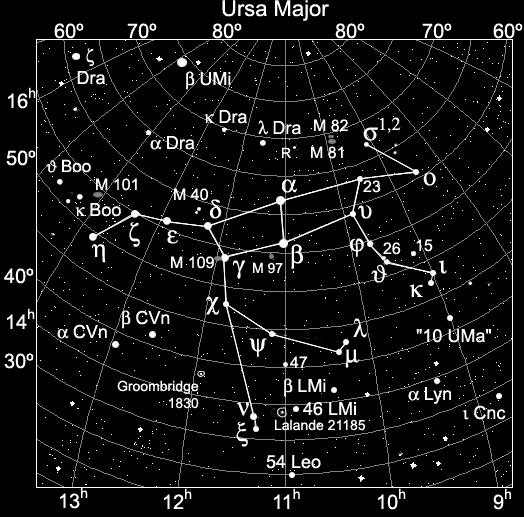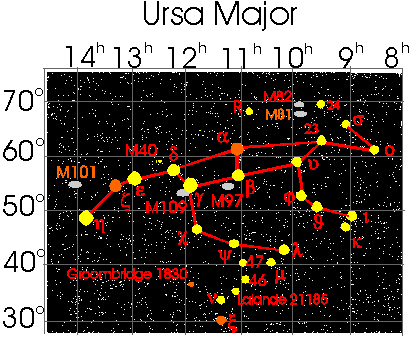
Ursa Major is circumpolar for northern hemisphere observers. Below the constellation is represented ‘right-side up’ as seen in mid-summer, however it may be too near the horizon at this time of year to study adequately. In winter it'll be seen upside down, and much higher in the skies. Not only is the 'Big Dipper' a familiar sight in northern skies, but the asterism also serves as a convenient pointer to a number of other stars. Ursa Major contains several notable binaries here, as well as a number of fine deep sky objects which, if not fully appreciated, can at least be found in binoculars.

Alpha Ursae Majoris is "Dubhe", The Bear. Dubhe forms the 'lip' of the dipper and in binoculars can be seen along with beta. The classic means of finding Polaris (and thereby the North Pole) is to draw a line from beta through alpha and continue it in the same direction. The other stars in strict alphabetical order which form the famous asterism are beta, gamma, delta, zeta, and eta.
Dubhe is a second-magnitude yellow giant, 125 light years away, with a 5th-mag companion which orbits the primary every 44.4 years. Presently the companion is drawing away from the primary, and will achieve its maximum distance (0.84") in the years 2022-2025. The asterism of the Big Dipper is so large that binoculars can only get two stars at a time in the same field of view. In the same FOV, are two Messier objects to the southeast, best studied in medium to large telescopes. In particular the Owl Nebula (M97), one of the largest known planetary nebulae, requires a very large telescope indeed as it is only an 11th-mag object with a 14th-mag central star.
Xi Ursae Majoris is a splendid binary, one of the most attractive in Ursa Major. This binary is the first to have had its orbit calculated, in 1828. The two similar stars (4.3, 4.4) are presently (2000.0) at PA 273º and 1.8" separation. Xi UMa is far to the south, and easiest to find from Leo Minor. Facing south, if you find beta LMi, then 46 LMi is at the far southeast corner of your glasses. If you put 46 LMi at the upper right edge then both nu UMa and xi UMa will be just visible on the other edge. From xi UMa and nu UMa you can now hop to Groombridge 1830, one of the 'fastest' stars known, with a proper motion of over 7 arcseconds. This means that in 511 years the star will have shifted its present position by one full degree.
Zeta Ursae Majoris is called "Mizar", girdle. It is the second star on the handle and is one of the most famous binary systems in the heavens. Binoculars, or even the naked-eye on exceptional nights, reveal the dimmer companion Alcor (80 UMa) at a position angle of 71º and a separation of 708". Observers once reasoned that the two were optical binaries only, not gravitationally bound to each other, since Mizar was thought to be 60 light years away, and Alcor 80. However, the Hipparcos satellite has calculated that Mizar's distance from us is 78 light years, and Alcor's is 81. Moreover they have nearly the same proper motion and therefore most probably form a true binary system. Mizar has another 4th-mag companion fixed at PA 152º and separation 14.4". From Mizar-Alcor the Messier object M101 is easily found, nearly in the same FOV. If Mizar is at the left-hand side of your glasses (it being winter and the constellation being upside down) then M101 will be just off the edge toward the right. Sweep the glasses half a field more to put M101 in the centre of your FOV.

Groombridge 1830 is notable for one thing, its the third fastest star with a proper motion of 7.058 arcseconds. This means that the star will have moved one entire degree in an apparent direction of 145º in just 511 years. The star is a rather bright dwarf, with a visual magnitude of 6.4, quite suitable for binoculars. To find Groombridge 1830 begin at xi UMa. Putting this star at the extreme northeast corner of your glasses (in winter, the constellation and hence the directions are upside down!) you'll see two fairly bright stars at the other side of your glasses. These are 61 UMa and 62 UMa. Now put 61 UMa at the top of your glasses a little off centre. A line of three 6th-mag stars brings you to a small group of stars.